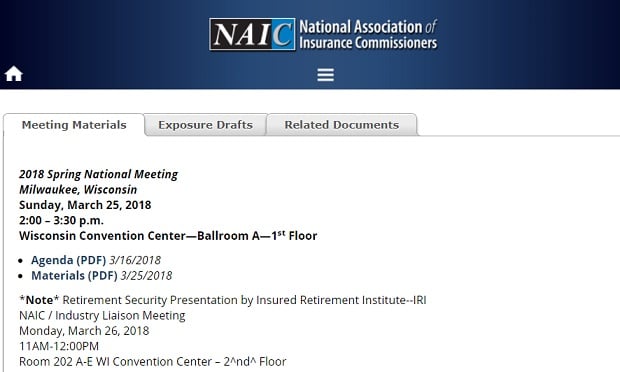Variable annuity regulation writers are fighting a complicated capital requirement fight that has raised a simple, painful question: What if the managers of a financial services company stop caring about the fate of a life insurance company affiliate?
Two panels at the National Association of Insurance Commissioners have drawn attention to the plight of life insurance companies that are in their corporate families’ doghouse while looking into ways to improve reserve and capital standards for variable annuities.
(Related: State Insurance Regulators Eye Their Rivals in Basel)
One of the many battles is over how the issuers — and their accountants, actuaries and regulators — should treat the revenue that variable annuity-issuing life insurers are supposed to get from investment company sister companies in crisis conditions, when the revenue streams are not legally guaranteed.
The Fight
Today, when variable annuity insurers are looking at how they might do in a crisis, they’re supposed to use an Actuarial Guideline 43 framework to determine how much they might really get through the non-guaranteed arrangements. The issuers can count on getting 100% of the non-guaranteed revenue in the first year, for example, but only 50% of the non-guaranteed revenue in years six and later, whether the revenue is supposed to come from affiliates or outside companies.
Another, newer regulatory approach now being phased in, the more flexible C3 Phase II principles-based reserving framework, would let an annuity issuer’s actuary make a “prudent estimate” about what might happen to the non-guaranteed revenue.
Consultants at Oliver Wyman, who are helping the NAIC panels with the project, suggested in a set of recommendations released in December that regulators should compromise.
The consultants said regulators should let insurers use the flexible, C3 Phase II approach for non-guaranteed revenue-sharing from outside companies, but stick with the current Actuarial Guideline 43 approach for an issuer’s sister companies, to give the sister companies an incentive to add guarantees to the revenue-sharing arrangements.
The American Council of Life Insurers wants regulators to apply the more flexible Actuarial Guideline 43 approach to all revenue-sharing arrangements.
In times of stress, a financial services company would probably be trying to put money into a distressed life insurer affiliate to get its capital up to the right level, not trying to cut off revenue-sharing payments, the ACLI reps write in a comment letter.
The U.S. Securities and Exchange Commission regulates how an investment fund must treat an affiliated service provider, the ACLI reps add.
Amanda Fenwick, a life actuary at the New York State Department of Financial Services, says she objects to the Oliver Wyman compromise proposal.
“The current standard should not be weakened to allow non-guaranteed revenue-sharing,” Fenwick writes.
Tom Campbell, chair of a work group at the American Academy of Actuaries, has suggested that regulators should define revenue-sharing-related terms more precisely and get more data on existing revenue-sharing arrangements.
Once everyone understands the revenue-sharing-arrangement issue better, regulators should develop flexible, principles-based criteria for describing the circumstances in which actuaries might give a variable annuity issuer more credit for a revenue-sharing arrangement, Campbell writes.
The Oliver Wyman consultants say they think their compromise proposal is better than assuming that an investment company’s managers will always do their best to stabilize a struggling life insurance company affiliate
“Our recommendation reflects a concern about a case when the operating entity is highly distressed and offers little appreciable value to the beneficial owner,” the consultants write. “In such circumstances, whether the entity enters receivership with a mild or severe expected shortfall (i.e. upon loss of revenue sharing) is of less consequence to the beneficial owner.”
The History
The NAIC — a Kansas City, Missouri-based group for insurance regulators — has been developing and updating variable annuity capital and reserve standards for decades.
In the current U.S. insurance regulation world, the term “reserves” refers to the amount of assets needed, under insurance statutes, to cover current and future obligations.
“Capital” refers to the difference between the statutory reserve requirements and the “total asset requirement” amount. The “total asset requirement” is the amount of assets an insurer really appears to need to meet its obligations, based on use of modern statistical forecasting tools. An insurer is supposed to use those tools to see what its assets and obligations might look like under a wide range of conditions, or “scenarios.”
In recent years, regulators have shifted toward more use of “principles-based reserving” rules, or rules based on general guidelines, use of modern statistical forecasting methods, and reliance on actuaries to use their best judgment to come up with accurate assessments of current and past conditions, and reasonable predictions about the future.
Lfe insurers typically ask the NAIC to give them more flexibility, and to choose rules that will maximize their official reserve and capital levels.
Actuarial groups typically ask the NAIC to choose rules that rely as much as possible on a principles-based approach, or reliance on actuarial judgment.
Regulators in New York state, and, in some cases, other states, often encourage the NAIC to stick to traditional, conservative rules, with standardized reserving formulas, and minimum capitalization level requirements that apply to all insurers in a given class of insurers.
The NAIC panels looking at the reserve and capital issues for variable annuities now are the Variable Annuities Issues Working Group and the C-3 Phase II/AG43 Subgroup. The groups are planning to hold an in-person meeting in Kansas City, Missouri , on Wednesday.
The Variable Annuities Issues Working Group have posted a packet of documents related to the meeting here.
— Read New York Proposes PBR Guidelines on ThinkAdvisor.
— Connect with ThinkAdvisor Life/Health on Facebook and Twitter.







 May 11, 2018 at 02:38 PM
May 11, 2018 at 02:38 PM
















 Slideshow
Slideshow





